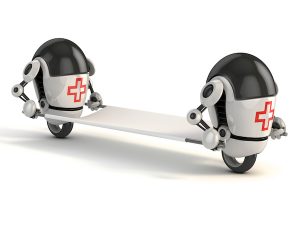Robots have been, and still are, a staple of Sci-Fi movies and novels. However, the evolution of technology is quickly bringing them into the medical fields as well.
According to one report by Credence Research, the global medical robotics market was valued at $7.24 billion in 2015 and is expected to grow to $20 billion by 2023. A key driver for this growth is demand for using robots in minimally invasive surgeries, especially for neurologic, orthopedic, and laparoscopic procedures.
Because of this, there’s a wide range of robots in development that will serve in a variety of roles within the medical environment. Ones specializing in human treatment include surgical and rehabilitation robots. The field of assistive and therapeutic robotic devices is also expanding greatly. Those types of robots include ones that help patients rehabilitate from a number of serious conditions like strokes; empathic robots that assist in the care of the elderly or physically/mentally challenged individuals; and industrial robots that take on a variety of routine tasks, such as delivery of medical supplies and equipment, delivery medications and sterilizing rooms after use.
Here are three ways medical robots are currently being used:
Surgical assistants:
These remote-controlled robots can assist surgeons in regard to performing operations – typically in relationship to minimally invasive procedures. “The ability to manipulate a highly sophisticated robotic arm by operating controls, seated at a workstation out of the operating room, is the hallmark of surgical robots,” says Dr. Bernadette Keefe, a healthcare and medicine consultant based in Chapel Hill, NC.
Other applications for surgical-assistant robots are continually being developed. With the influx of advanced 3DHD technology, these robots can give the surgeon the spatial references needed when performing highly complex surgery, including a more enhanced natural stereo visualization, combined with augmented reality.
Rehabilitation partners:
A robot designed for rehabilitation will play a crucial role in the recovery of people with disabilities – including improved mobility, coordination, quality of life, and strength. They are programmable to adapt to the condition of the individual to assist in their recovery from traumatic brain or spinal cord injuries, strokes or neurobehavioral or neuromuscular diseases such as multiple sclerosis. Virtual reality integrated with rehabilitation robots can also improve balance, walking, and other motor functions.
Medicine Dispensing systems:
The biggest advantages of robots are speed and accuracy, two features that are very important to pharmacies. Automated dispensing systems have advanced to the point where robots can now handle powder, liquids, and highly viscous materials, with much higher speed and accuracy than before.
Advances in medical robots continue to be developed in the ever-expanding field of medicine. Existing technologies are being combined in new ways that will streamline healthcare operations across the globe.
With the integration and development of systems, comes the necessity to ‘see’ the intended target with extreme accuracy. At Universe Optics, we pride ourselves on designing precision lenses that are available to use in medical robots. Should you require a lens with a set of specific parameters, our team is here to ensure we craft one designed exactly for your equipment.